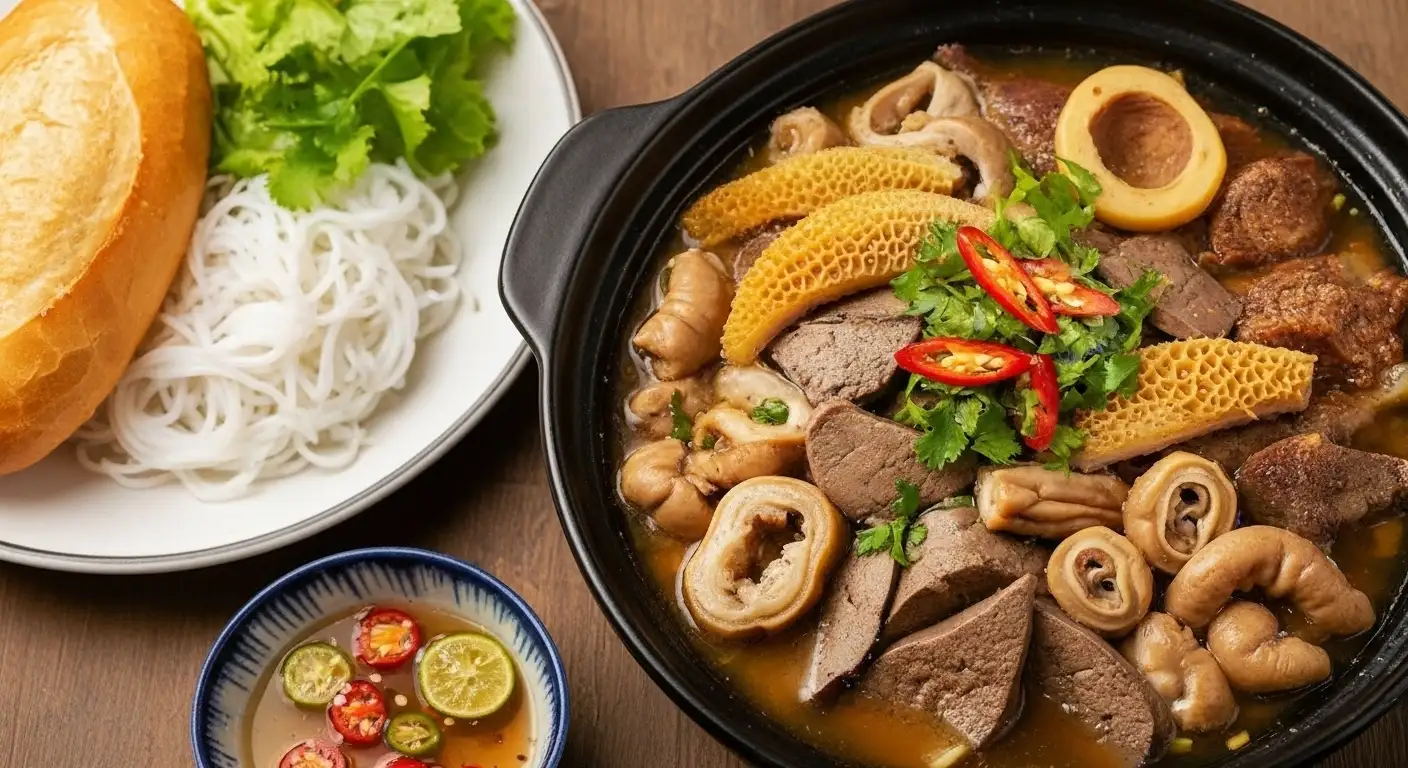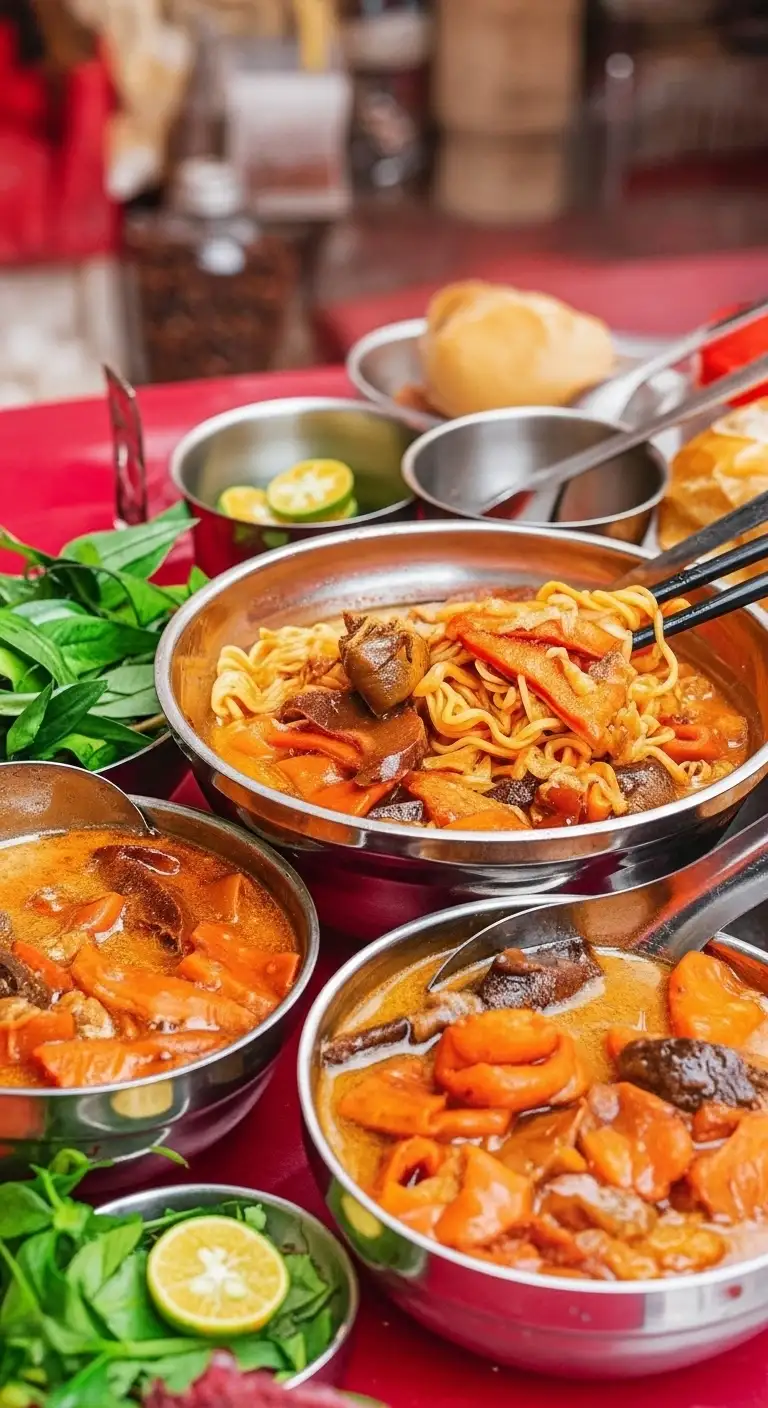Phá Lấu (pronounced fa laow) is an iconic, hearty, and aromatic Vietnamese stew, most famously associated with the street food scene of Ho Chi Minh City (Saigon). It is a working-class delicacy that transforms often-overlooked cuts of meat and offal into a deeply savory and complex meal.
The Basics of Phá Lấu
What is it?
Phá Lấu is a rich stew made from various animal offal (such as pig or cow intestines, ears, liver, and stomach) that is braised for hours until tender.
The Origin and Influence:
The dish is believed to have originated from the Teochew (Hoa people) community in Southern Vietnam, where the term lấu refers to a red-braise cooking technique. However, the Vietnamese version, especially the street food variety, has evolved into a unique and beloved Southern staple.
The Key Flavor:
The organs are simmered in a complex, spiced broth. The dominant flavors come from Five-Spice Powder (cinnamon, star anise, cloves, fennel seeds, and Sichuan pepper), along with a generous addition of coconut milk or coconut water.
The Texture:
The long simmering process makes the offal incredibly tender and soft, while still retaining a satisfyingly chewy or slightly crunchy texture in parts like the ears and intestines.
The Broth:
The broth is a distinct orange-hued liquid (due to curry powder or turmeric often being included), which is sweet, savory, and rich with a pronounced coconut aroma.

Types and Variations of Phá Lấu
Phá Lấu is primarily defined by the type of meat used, but the core preparation (braised in a spiced, coconut-based broth) remains consistent.
| Type Name | Main Ingredient | Flavor Notes |
|---|---|---|
| Phá Lấu Bò | Cow/Beef Offal (Bò - Beef) | The most common and popular style, especially in Saigon. It is made from various beef innards (stomach, lungs, heart) and simmered until very tender. |
| Phá Lấu Heo | Pork Offal (Heo - Pork) | A classic variation using pig's organs (intestines, ears, tongue). This version tends to be fattier and richer. |
| Phá Lấu Chay | Vegetarian Phá Lấu | A modern, meatless version where the offal is replaced with fried tofu, mushrooms, and taro, cooked in the same spiced coconut broth. |
| Phá Lấu Khô | Dry Phá Lấu | This refers to a serving style where the organs are pulled from the broth, sliced, and then stir-fried or caramelized with a thicker sauce, offering a more intense, savory flavor. |
How to Eat Phá Lấu
Eating Phá Lấu is a communal and customizable street-food experience, almost always involving dipping and bread.
Select Your Base: Phá Lấu is versatile and can be served over several bases:
Bánh Mì (Bread): The most classic way. The braised organs are served in a small bowl with a ladle of broth, and a fresh, crusty Vietnamese baguette is used to scoop up the broth and meat.
Mì Gói (Instant Noodles): The broth and organs are poured over a bed of boiled instant noodles, turning the dish into a hearty soup.
Cơm (Rice): Served as a side dish over steamed white rice.
The Dipping Sauce: This is a non-negotiable step. The small wooden sticks provided are used to pierce a piece of offal, which is then dipped into a specialized sauce before eating.
Classic Sauce: A mixture of salt, pepper, and chili, brightened with a squeeze of lime or kumquat juice. This sour and spicy sauce is essential for cutting through the richness of the stew.
The Experience: It is usually eaten hot, often from street carts, providing a burst of sweet, savory, and spicy flavor in every chewy, tender bite.

Regional Differences
Phá Lấu is fundamentally a specialty of Southern Vietnam, specifically Ho Chi Minh City (Saigon). It is virtually unknown in the North and has limited presence in the Central region.
| Region | Status and Style of Phá Lấu | Key Differences |
|---|---|---|
| Northern Vietnam | Non-existent/Extremely Rare. | Northern cuisine emphasizes clean, subtle, and balanced flavors. Offal dishes exist, but the concept of braising organs in a rich, sweet, coconut-based, five-spice broth is not a traditional Northern style. |
| Central Vietnam | Limited/Different Offal Dishes. | While offal is utilized in some Central dishes (like Bún Bò Huế), Phá Lấu as defined by the coconut-braise is not a native Central dish. Central Vietnamese cuisine is known for its intensity and use of chili and fermented shrimp paste (Mắm), making its offal dishes generally spicier and saltier. |
| Southern Vietnam (Ho Chi Minh City) | Native Staple. The dish reached its culinary peak here, becoming a popular, accessible street food snack. The use of coconut milk and sugar in the broth is a signature trait of Southern cuisine. | Defining Flavor: Rich, sweet, and aromatic broth thanks to the heavy use of coconut milk. Defining Pairing: Served most often with Bánh Mì and a kumquat-chili-salt dipping sauce. |




